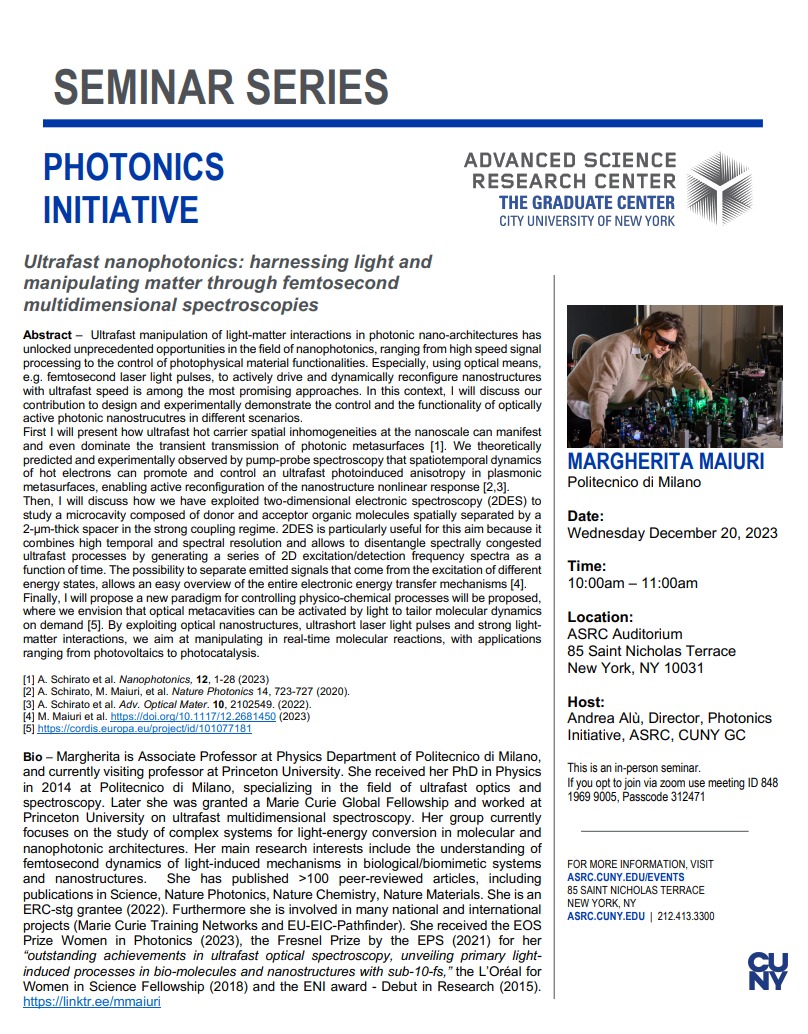
Ultrafast nanophotonics: harnessing light and manipulating matter through femtosecond multidimensional spectroscopies
Abstract – Ultrafast manipulation of light-matter interactions in photonic nano-architectures has unlocked unprecedented opportunities in the field of nanophotonics, ranging from high speed signal processing to the control of photophysical material functionalities. Especially, using optical means, e.g. femtosecond laser light pulses, to actively drive and dynamically reconfigure nanostructures with ultrafast speed is among the most promising approaches. In this context, I will discuss our contribution to design and experimentally demonstrate the control and the functionality of optically active photonic nanostrucutres in different scenarios.
First I will present how ultrafast hot carrier spatial inhomogeneities at the nanoscale can manifest and even dominate the transient transmission of photonic metasurfaces [1]. We theoretically predicted and experimentally observed by pump-probe spectroscopy that spatiotemporal dynamics of hot electrons can promote and control an ultrafast photoinduced anisotropy in plasmonic metasurfaces, enabling active reconfiguration of the nanostructure nonlinear response [2,3]. Then, I will discuss how we have exploited two-dimensional electronic spectroscopy (2DES) to study a microcavity composed of donor and acceptor organic molecules spatially separated by a 2-μm-thick spacer in the strong coupling regime. 2DES is particularly useful for this aim because it combines high temporal and spectral resolution and allows to disentangle spectrally congested ultrafast processes by generating a series of 2D excitation/detection frequency spectra as a function of time. The possibility to separate emitted signals that come from the excitation of different energy states, allows an easy overview of the entire electronic energy transfer mechanisms [4]. Finally, I will propose a new paradigm for controlling physico-chemical processes will be proposed, where we envision that optical metacavities can be activated by light to tailor molecular dynamics on demand [5]. By exploiting optical nanostructures, ultrashort laser light pulses and strong light- matter interactions, we aim at manipulating in real-time molecular reactions, with applications ranging from photovoltaics to photocatalysis.
[1] A. Schirato et al. Nanophotonics, 12, 1-28 (2023)
[2] A. Schirato, M. Maiuri, et al. Nature Photonics 14, 723-727 (2020). [3] A. Schirato et al. Adv. Optical Mater. 10, 2102549. (2022).
[4] M. Maiuri et al. https://doi.org/10.1117/12.2681450 (2023)
[5] https://cordis.europa.eu/project/id/101077181
Bio – Margherita is Associate Professor at Physics Department of Politecnico di Milano, and currently visiting professor at Princeton University. She received her PhD in Physics in 2014 at Politecnico di Milano, specializing in the field of ultrafast optics and spectroscopy. Later she was granted a Marie Curie Global Fellowship and worked at Princeton University on ultrafast multidimensional spectroscopy. Her group currently focuses on the study of complex systems for light-energy conversion in molecular and nanophotonic architectures. Her main research interests include the understanding of femtosecond dynamics of light-induced mechanisms in biological/biomimetic systems and nanostructures. She has published >100 peer-reviewed articles, including publications in Science, Nature Photonics, Nature Chemistry, Nature Materials. She is an ERC-stg grantee (2022). Furthermore she is involved in many national and international projects (Marie Curie Training Networks and EU-EIC-Pathfinder). She received the EOS Prize Women in Photonics (2023), the Fresnel Prize by the EPS (2021) for her “outstanding achievements in ultrafast optical spectroscopy, unveiling primary light- induced processes in bio-molecules and nanostructures with sub-10-fs,” the L’Oréal for Women in Science Fellowship (2018) and the ENI award – Debut in Research (2015). https://linktr.ee/mmaiuri

